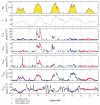BVOC fluxes above mountain grassland
- PMID: 24339833
- PMCID: PMC3856874
- DOI: 10.5194/bg-7-1413-2010
BVOC fluxes above mountain grassland
Abstract
Grasslands comprise natural tropical savannah over managed temperate fields to tundra and cover one quarter of the Earth's land surface. Plant growth, maintenance and decay result in volatile organic compound (VOCs) emissions to the atmosphere. Furthermore, biogenic VOCs (BVOCs) are emitted as a consequence of various environmental stresses including cutting and drying during harvesting. Fluxes of BVOCs were measured with a proton-transfer-reaction-mass-spectrometer (PTR-MS) over temperate mountain grassland in Stubai Valley (Tyrol, Austria) over one growing season (2008). VOC fluxes were calculated from the disjunct PTR-MS data using the virtual disjunct eddy covariance method and the gap filling method. Methanol fluxes obtained with the two independent flux calculation methods were highly correlated (y = 0.95×-0.12, R2 = 0.92). Methanol showed strong daytime emissions throughout the growing season - with maximal values of 9.7 nmol m-2 s-1, methanol fluxes from the growing grassland were considerably higher at the beginning of the growing season in June compared to those measured during October (2.5 nmol m-2 s-1). Methanol was the only component that exhibited consistent fluxes during the entire growing periods of the grass. The cutting and drying of the grass increased the emissions of methanol to up to 78.4 nmol m-2 s-1. In addition, emissions of acetaldehyde (up to 11.0 nmol m-2 s-1), and hexenal (leaf aldehyde, up to 8.6 nmol m-2 s-1) were detected during/after harvesting.
Figures









References
-
- Aubinet M, Grelle A, Ibrom A, Rannik Ü, Moncrieff J, Foken T, Kowalski AS, Martin PH, Berbigier P, Bernhofer Ch., Clement R, Ebers J, Granier A, Grünwald T, Morgenstern K, Pilegaard K, Rebmann C, Snijders W, Valentini R, Vesala T. Estimates of the annual net carbon and water exchange of forest: the EUROFLUX methodology. Adv. Ecol. Res. 2000;30:113–175.
-
- Baldocchi DD, Hicks BB, Meyers TP. Measuring biosphere-atmosphere exchangesof biologically related gases with micrometeorological methods. Ecology. 1988;69:1331–1340.
-
- Beauchamp J, Wisthaler A, Hansel A, Kleist E, Miebach M, Niinemets U, Schurr U, Wildt J. Ozone induced emissions of biogenic voc from tobacco: Relationships between ozone uptake and emission of lox products. Plant Cell Environ. 2005;28:1334–1343.
-
- Bertin N, Staudt M. Effect of water stress on monoterpene emissions from young potted holm oak (quercus ilex 1.) trees. Oecologia. 1996;107:456–462. - PubMed
-
- Brunner A, Ammann C, Neftel A, Spirig C. Methanol exchange between grassland and the atmosphere. Biogeosciences. 2007;4:395–410.
Grants and funding
LinkOut - more resources
Full Text Sources
Miscellaneous
